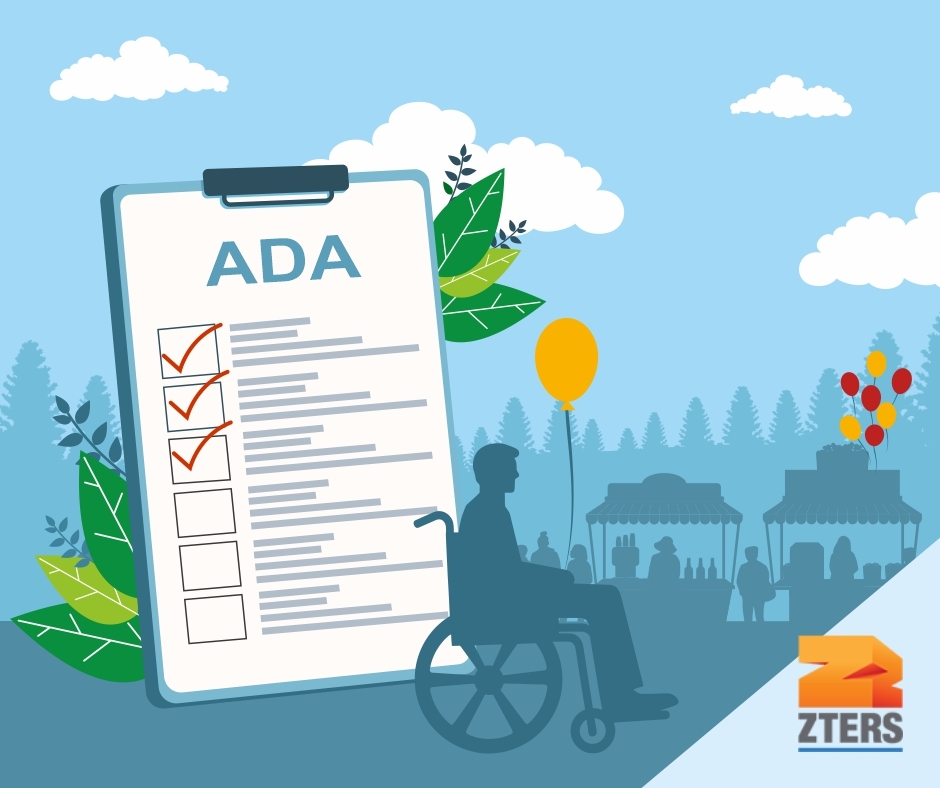To ensure that events can be enjoyed by everyone, it is essential for event organizers to prioritize accessibility for all attendees. The Americans with Disabilities Act (ADA) sets forth guidelines to ensure that events are accessible to everyone.
To help aid understanding on how to implement these guidelines, we’re sharing some key insights and takeaways from the ADA Planning Guide for Making Temporary Events Accessible to People with Disabilities. Our aim is to help organizers create events that are inclusive and welcoming to everyone.
Understanding ADA Event Regulations
The ADA guide emphasizes that temporary events — such as conferences, fairs, or festivals — should be designed with accessibility in mind from the outset. This means addressing various aspects of the event, including physical accessibility, communication, and accommodations for different disabilities.
Here’s what the Guide has to say about planning:
At a temporary event participants with disabilities must be able to:
- Obtain information and directions prior to the event.
- Arrive at the site in the same ways as others can (e.g. via private automobile, taxi, public transportation, event shuttles).
- Find and use accessible parking.
- Get from accessible parking to entrances.
- Obtain additional information and directions on site.
- Move around the site as needed.
- Attend performances, participate in activities, and enter exhibits.
- Experience and enjoy activities, even if the participant’s disability affects their ability to communicate.
- Select and purchase items at concessions.
- Use public toilet rooms, telephones, water fountains, shelters, first aid stations, and other common amenities.
Physical Accessibility
- Entrances and Exits: Ensure that entrances and exits are wheelchair accessible, providing ramps or lifts when necessary. Event organizers should have clear signage directing wheelchair users and others with mobility challenges to nearby accessible entrances.
- Path of Travel: Maintain clear, wide pathways to accommodate individuals using mobility devices. People with disabilities should be able to use the same paths as able-bodied people whenever possible.
- Parking: Designate accessible parking spaces as close to the accessible entrance as possible and ensure proper signage. If event parking is off-site, you may want to consider creating a makeshift on-site parking option. It’s also worth noting that parking spaces once considered accessible before passage of the ADA may not be adequate today.
- Seating: Provide wheelchair-accessible seating options with a clear line of sight to the event. Standards require that 5% (but never less than one) of all fixed or built-in tables and seating, be accessible. There should be adequate knee space and the table should be at an appropriate height for people using wheelchairs to sit comfortably.
Communication
- Information Accessibility: Make event information available in accessible formats, such as Braille, large print, or electronic formats compatible with screen readers. Social media can be a great tool for getting the word out. Ensure that any images have descriptive text and any videos have closed captioning.
- Signage: Use clear and visible signage with easy-to-read fonts and high color contrast.
- Announcements: Provide real-time captioning or sign language interpreters for important announcements.
Accommodations
- Service Animals: Allow individuals with disabilities to bring their service animals to the event. This may mean modifying a no-pet policy, especially considering the fact that service animals are not classified as pets.
- Restrooms: Ensure that restroom facilities are accessible, adequately sized, and equipped with proper support bars, as seen in ADA compliant porta potties. ADA Standards require at least 5% of portable toilet units to be accessible.
- Quiet Spaces: Designate quiet spaces for individuals who may need a break from sensory stimuli.
Planning an Event?
Speak with an account manager to bundle all your rental needs.
Event Staff Training
- Disability Awareness Training: Train event staff on disability awareness and the specific needs of attendees with disabilities. Allow staff to ask questions and provide diagrams/demonstrations for reference if necessary.
- Emergency Procedures: Develop and communicate clear emergency procedures that consider the needs of individuals with disabilities. While it’s not required to provide emergency medical services apart from those available to the general public, it’s important to ask the individual directly what they need if anything arises.
Implementing ADA Regulations is a Must!
Organizers should take a proactive approach to inclusivity by incorporating accessibility considerations into the event planning process. There are tons of online resources to help ensure that you’re doing as much as you can to create an inclusive space. When in doubt, ask!
By adopting inclusive practices, event organizers not only comply with ADA regulations but also create a more positive and welcoming environment for all attendees. ZTERS is your partner in creating more inclusive events from ADA compliant portable toilets to crowd control fencing. Get in touch to learn more about how we can enhance your event.

